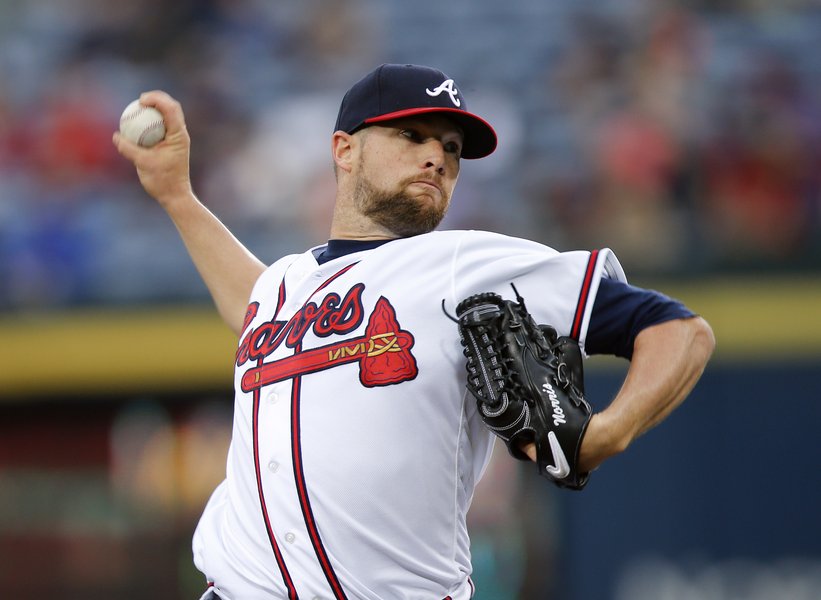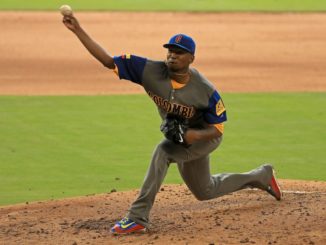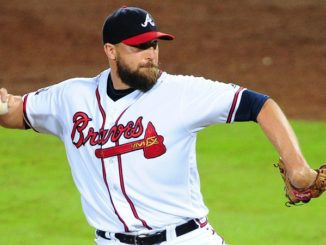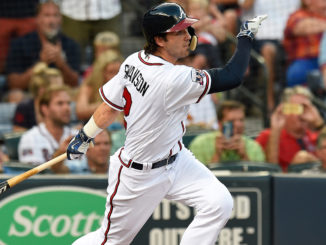Trade Analysis: Atlanta sends RHP Bud Norris, OF Dian Toscano, a player to be named later, and cash to the Los Angeles Dodgers for LHP Philip Pfeifer and RHP Caleb Dirks
(I wish I could blame that on a headline writer, but no, that’s all me. Mea culpa.)

On Thursday, Atlanta pulled the trigger on one of the more obvious trades of the summer: the jettisoning of right handed pitcher Bud Norris. In the deal, Atlanta sent Norris, OF Dian Toscano, a player to be named later, and cash considerations to the Los Angeles Dodgers for two pitchers, lefty Philip Pfeifer and righty Caleb Dirks.
Norris, signed in the offseason to a one year, $2,500,000 deal, had a season that is conveniently broken up into thirds. He began the year as a starter, then was sent to the bullpen, and then, due to injuries, returned to the rotation. Here’s how that looked:
Starter v1.0 – 5 games, 22.2 IP, 17 Ks, 11 BBs, .340/.398/.580, 8.74 ERA
Reliever – 12 games, 18.1 IP, 14 Ks, 9 BBs, .217/.338/.250, 1.96 ERA
Starter v2.0 – 5 games, 29.1 IP, 29 Ks, 8 BBs, .200/.254/.248, 2.15 ERA
After 5 starts to begin the season, some were discussing whether Atlanta should bite the bullet and DFA Norris. Instead, the Braves gave Norris a shot in the ‘pen, where he had some success in San Diego a year ago. It worked. Bud rebuilt some value, and suddenly he was a commodity worth trading for. In the span of a month, Norris went from a player that likely wouldn’t have been claimed on waivers to a player a team was willing to trade prospects AND take on money for. That’s quite a month.
Norris held no long-term value to Atlanta, which made the decision to trade him easy, but at the same time, Atlanta never really had any trade leverage in these talks. Even with his great months of May and June, this is still the same pitcher who was available so cheaply thanks to a 6.72 ERA in 2015. There’s a good chance Norris regresses and is replacement-level or worse again. He simply wasn’t going to command a big return, and Atlanta had roughly 30 days to deal him. The clock was ticking on Bud’s time in Atlanta. At the time of the deal, Norris was owed $1,300,000 more this season, so chalk that up initially as savings for Atlanta, though the “cash considerations” are always a bit tricky.
Signed out of Cuba before 2015 to a 4 year, $6,000,000 deal, we waited an entire year for Dian Toscano’s debut. There seemed to always be talk of Toscano, but he took forever to arrive. When Toscano finally got on the field as a 27 year old in AA this season, he slashed .226/.310/.271. Welp. There was enough raw talent there to justify the investment to begin with, but his remaining salary – still at least $3.5M over the next 2+ years – is more palatable for a team like LA, which prints its own money. Atlanta is happy to have that cash, even if it’s a relatively smaller total, to re-allocate to arbitration deals and future free agents.
The two pitchers coming to Atlanta aren’t highly promising prospects, but they are interesting. Pfeifer is a hard throwing lefty who sits around 95 mph with his fastball, with a promising enough changeup to think a future as a reliever is possible. It’s not probable at this point, mostly due to mechanical issues. He reportedly struggles with repeating his delivery, and his command as a result is inconsistent. Pfeifer is 2 weeks away from his 24th birthday, and he has yet to reach AA. I think his upside is something on par with what Ian Krol already is. Not terribly exciting, but a AAAA lefty, and that’s enough to carve out some kind of major league career if he hits his ceiling. Most likely, Pfeifer is an organizational arm, but with a 95 mph fastball coming from the left side, he’ll get opportunity after opportunity to prove he’s something more.
Dirks, 23, is more advanced and more promising. Traded by Atlanta to Los Angeles a year ago for international pool money, Dirks returns to the Atlanta organization with 44.2 more AA innings than when he left. Moreover, they’ve been wildly successful innings. He strikes out plenty, doesn’t issue too many walks, and his ERAs resemble WHIPs. There’s some upside here, as I could see Dirks finding himself as a functional member of a MLB bullpen in the not distant future. He’s unlikely to be a closer candidate, and he’s no sure thing, but he’s useful to have around.
All in all, it’s a pretty acceptable trade for both sides, depending on the PTBNL and cash considerations. Speaking of, what should those cash considerations be? To answer that, I’ll try to find the true value of each player involved.
Norris has a cost, or negative value, of $1.3M. I estimate he’ll be worth around half a win to the Dodgers through the rest of his contract, especially if they use him as a reliever down the stretch. For a team in competition, I estimate one win to be worth around $10M, which might even be conservative. That half win value of $5M gives him a surplus value in 2016 of +$3.7M.
Toscano may very well amount to something useful, but he shouldn’t be seen as a prospect of any importance. With that in mind, I’m counting his remaining salary – $500K in 2016, $1.3M in 2017, $1.5M in 2018, and a $200K buyout for 2019, as cumulatively negative. Toscano is worth, by my estimations, -$3.5M.
When it comes to estimating prospect value, I’m a fan of this post from Beyond the Boxscore. However, those numbers are from 2009. I’ll need to adjust for inflation, which I’ve scribbled down on a notebook that you can’t see. Just… trust me? I’m setting a baseline value of $200K for any players that aren’t good enough to slot into one of the rows from the chart in the linked post. I arbitrarily picked this number.
Pfeifer is too raw, risky, and unproven to really put any kind of optimistic value on, so he gets the minimum $250K, but as I should probably apply that to Toscano as well, I’ll call them a wash. Dirks, on the other hand, is seen as a more promising prospect, receiving a borderline C grade from prospect guru John Sickels this offseason. After his results so far in 2016, I feel very comfortable with that C no longer being borderline. I estimate Dirks has a surplus value of $2.4M.
That puts Atlanta into the black here by a total of $2.2M. I don’t expect the PTBNL to be anyone significant, so we’ll put that value down as $200K, bringing it to a round sum of $2.0M. In my estimation (I know I’ve used that phrase a lot, but it’s important to stress that’s all this is), Atlanta should send $2,000,000 to Los Angeles in the deal to make it a truly fair trade. If the Braves wind up sending more, I would consider it an underwhelming return. If Atlanta sends less, and I suspect they will, I’ll like the trade more for the Braves.
However, all that’s in a vacuum. If you look at the big picture of where Bud Norris was two months ago, getting anything in return, much less a useful relief prospect and a lottery ticket lefty, has to feel like a pretty big win. Norris was signed with this moment in mind. Atlanta can’t sign players out of other systems, so they sign free agents and trade them for these players. For a month, it didn’t look like that strategy would work with regard to the Norris signing. The Braves should count themselves a bit lucky and very happy that it did.




Leave a Reply